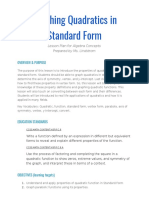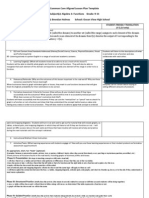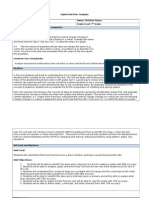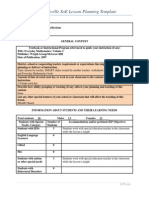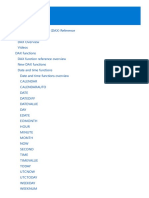Unitplanalgebra 1
Unitplanalgebra 1
Uploaded by
api-243290219Copyright:
Available Formats
Unitplanalgebra 1
Unitplanalgebra 1
Uploaded by
api-243290219Original Title
Copyright
Available Formats
Share this document
Did you find this document useful?
Is this content inappropriate?
Copyright:
Available Formats
Unitplanalgebra 1
Unitplanalgebra 1
Uploaded by
api-243290219Copyright:
Available Formats
Unit Design Template EDUC 343 Ubd Format
Title of Unit: Linear Functions
Stage 1: Desired Results
NJCCCS: Strand and CPI A.REI.5, A.REI.6, A.REI.10, A.REI.11, A.REI.12, F.IF.1, F.IF.2, F.IF.3, F.IF.5, F.IF.7, F.IF.9 Understandings
What will students understand (about what topics and big ideas) as a result of the unit that you hope they will remember five years from now? Students will understand that This information is usually taken from the content outline of the course curriculum guide.
Students will understand that the difference between relations and functions is that in a function each element of the domain is paired with exactly one element of the range. Students will understand that the equation of a line gives you the x-intercept, the y-intercept, and the slope of the line. Students will understand that the slope of the line can change the steepness as well as the positivity or negativity of the graph. Students will understand that parallel lines have no solution, lines that intersect at one point have one solution, and all other lines have infinitely many solutions. Students will understand that addition, subtraction, multiplication, and division can be used to solve inequalities. Essential Questions
What arguable, recurring, and thoughtprovoking questions will guide inquiry and point toward the big ideas of the unit? The understandings above are typically the answers to these.
Knowledge & Skill
What is the key knowledge and skills (building blocks) needed to develop the desired understandings and master the standards on which this unit is based?
What are the differences and similarities between relations and functions? What information does the equation of a line give you?
Understand the concepts of a relation and a function, and determine whether a given relation defined by a graph, a set of ordered pairs, or a symbolic expression is a function. Graph a linear equation, compute an equations x- and y-intercepts, and derive linear equations
Unit Design Template EDUC 343 Ubd Format
How does the slope of a line effect a graph? How can you determine whether a system of linear equations has no, one, or infinitely many solutions? What are the different ways that inequalities can be solved? by using the point-slope formula. Find the slope of a line and use it to graph a linear equation. Solve a system of two linear equations in two variables algebraically and interpret the answer graphically. Solve absolute value inequalities, multistep problems involving linear inequalities in one variable, and solve a system of two linear inequalities in two variables.
Stage 2: Assessment Evidence
What evidence will be collected to determine whether or not the understandings have been developed, the knowledge and skill attained, and the state standards met? [Anchor the work in performance tasks that involve application, supplemented as needed by prompted work, quizzes, observations, etc.]
Performance Task Summary (Project)
What product or performance will be used to gather evidence of understanding within this unit?
Rubric Criteria for Project
What aspects of that product or performance could be used as evidence of understanding and what are your levels of expectations for those aspects? (See template)
Unit Project: Rate of Change and Slope Have students stack three books on a desk. Students should then lean a ruler on the books to create a ramp, and tape the ruler to the desk. The students will then measure the rise over run and put it into a table. Students will then move the books closer to the ruler three more times to make the ramp steeper, and will again record the slope. Students will then add another book and see how that affects the slope. Students will then answer the following questions using the results. 1. How do the ratios change as the ramp becomes steeper? 2. What happens to the ratio when the run
-Students will correctly determine what the rise is. -Students will correctly determine what the run is. -Students will correctly determine the slope. -Students will correctly determine how ratios of the slope are affected. -Students will demonstrate their knowledge of how slope affects a graph and an equation.
Unit Design Template EDUC 343 Ubd Format
stays the same but the rise increases? 3. Suppose you want to build a shake board ramp with a slope less then the slope with a rise of 18in and a run of 24in. List three sets of rise over run measurements that will result in a ramp that is less steep and calculate their ratios. 4. Create four different equations that have the following slopes: negative, positive, zero, and undefined. Graph these equations on four separate pieces of graph paper. Self-Assessments (optional) Other Evidence, Summarized (i.e. quizzes, tests, homework, portfolios, exit tickets, etc.)
Students will rate how well they think they Students will be assigned homework problems. know the content on a scale of 1-5 at the end of Students will be given quizzes at the end of each chapter. each section. Students will be given tests at the end of each chapter. Students will be given an exit ticket. They will be asked what they learned on given day and what they think they need to work on. Students will get a Do Now in the beginning of the class.
Stage 3: Learning Activities
What sequence of learning activities and teaching will enable students to perform well at the understandings in Stage two and thus display evidence of the desired results in stage one? Should include: objectives, activities, and assessment for each class session.
Lesson 1 1. What will the students be able to do at the conclusion of this lesson? (Taken from Stage One) Students will understand that the difference between relations and functions is that in a function each element of the domain is paired with exactly one element of the range.
Unit Design Template EDUC 343 Ubd Format
2. this
What assessments (formal and informal) will you use to evaluate learning during lesson? (Taken from Stage Two) Students will complete a cooperative learning hand out, which will include problems different types of problems from each master! group.
".
What activities will the students participate in over the course of this lesson?
Students will be bro#en up into three groups in which they will learn to find the ordered pairs, the domain and range, the inverse, and they will determine whether or not the relation is a function. $he information will be presented to these groups in different ways. Students will then be put into a new in a new group in which they will teach the others students what they learned through a mini lesson. $hen, they will wor# collaboratively on a wor#sheet to be handed in and graded at the end of class. Students will be given an e%it tic#et at the end of class in order to access what they have learned and what they need help with. Lesson 2 1. What will the students be able to do at the conclusion of this lesson? (Taken from Stage One) Students will understand that the equation of a line gives you the x-intercept, the yintercept, and the slope of the line. 2. What assessments (formal and informal) will you use to evaluate learning during this lesson? (Taken from Stage Two) Students will be complete a wor#sheet collaboratively in groups, which will include problems on finding the slope, %&intercept, and y&intercept. ". What activities will the students participate in over the course of this lesson? Students will be bro#en into three groups. 'ne group will become a master at slope, one of %&intercept, and one of y&intercept. $hen these masters will be put into different groups and will teach a mini lesson to the rest of their group. $hen, they will wor# collaboratively on wor#sheet to be handed in at the end of class. Students will be as#ed to rate how well they #now the content from 1&( (one being not at all and five being they #now it well) at the end of class. Lesson 3
Unit Design Template EDUC 343 Ubd Format
1. What will the students be able to do at the conclusion of this lesson? (Taken from Stage One) Students will understand that the slope of the line can change the steepness as well as the positivity or negativity of the graph. 2. What assessments (formal and informal) will you use to evaluate learning during this lesson? (Taken from Stage Two) Students will complete the )uestions on their own to be graded. Students will also be given an e%it tic#et in which they will write what they learned and what they need more help with. ". What activities will the students participate in over the course of this lesson? Students will be given the *nit +ro,ect! on -ate of .hange and Slope. Students will be .omplete the e%periment in class, and will be e%pected to answer the )uestions on their own for homewor#. Lesson 4 1. What will the students be able to do at the conclusion of this lesson? (Taken from Stage One) Students will understand that parallel lines have no solution, lines that intersect at one point have one solution, and all other lines have infinitely many solutions. 2. What assessments (formal and informal) will you use to evaluate learning during this lesson? (Taken from Stage Two) Students will be graded based on their group wor#. $hey will also be given a short )ui/ at the beginning of ne%t period. ". What activities will the students participate in over the course of this lesson? Students will wor# together in groups to determine whether a system of linear e)uations $hey will first graph these lines, then they will determine whether they have no solution, one solution, or infinitely many solutions. Lesson 5
Unit Design Template EDUC 343 Ubd Format
1. What will the students be able to do at the conclusion of this lesson? (Taken from Stage One) Students will understand that addition, subtraction, multiplication, and division can be used to solve inequalities. 2. What assessments (formal and informal) will you use to evaluate learning during this lesson? (Taken from Stage Two) Students will create an account on Socrative, which is an app they can get on their phone. $hrough this app, they will answer a few basic )uestions regarding the content and will be able to rate how well they thin# they #now the information. Students will also be graded on their group wor#. ". What activities will the students participate in over the course of this lesson? Students will be broken up into four different master groups: addition, subtraction, multiplication and division. Each master will create a mini lesson, which her or she will have to teach to their second group. The second group will get problems that are combinations of the different methods of solving equations. Students will have to work together in order to solve these problems.
Unit Design Template EDUC 343 Ubd Format
You might also like
- Mastering Essential Math Skills, Book 1: Grades 4 and 5, 3rd Edition: 20 minutes a day to successFrom EverandMastering Essential Math Skills, Book 1: Grades 4 and 5, 3rd Edition: 20 minutes a day to successNo ratings yet
- New Syllabus Additional Mathematics PDFDocument556 pagesNew Syllabus Additional Mathematics PDFRizwan Ul Haq100% (4)
- Calculus A Complete Introduction (Teach Yourself), 4th Edition PDFDocument384 pagesCalculus A Complete Introduction (Teach Yourself), 4th Edition PDFRohan Vijay Sarode97% (29)
- Solving One-Step InequalitiesDocument7 pagesSolving One-Step Inequalitiesapi-534102323No ratings yet
- Intro To Functions Using Singapore MathDocument8 pagesIntro To Functions Using Singapore Mathapi-251888079No ratings yet
- Parabola Catapult Lesson PlanDocument5 pagesParabola Catapult Lesson Planapi-352927285No ratings yet
- Slope-Intercept Lesson PlanDocument8 pagesSlope-Intercept Lesson Planapi-254064000No ratings yet
- Inquiry (5E) Lesson Plan TemplateDocument3 pagesInquiry (5E) Lesson Plan Templateapi-527239212No ratings yet
- Generalized Musical Intervals and Transformations 2Document3 pagesGeneralized Musical Intervals and Transformations 2Jose Maria Cañas RuizNo ratings yet
- Chapter9 Mathlinks8 UnitplanDocument10 pagesChapter9 Mathlinks8 Unitplanapi-271785617No ratings yet
- Lesson Plans Ed Tpa Task 1Document6 pagesLesson Plans Ed Tpa Task 1api-218854185No ratings yet
- 610 Lesson PlanDocument17 pages610 Lesson Planapi-334497184No ratings yet
- Stemlessonplan 3Document3 pagesStemlessonplan 3api-243290219No ratings yet
- Lesson 3 ArtifactDocument3 pagesLesson 3 Artifactapi-250140186No ratings yet
- Lesson Plan-Graphing Quadratics in Standard FormDocument3 pagesLesson Plan-Graphing Quadratics in Standard Formapi-438162770No ratings yet
- Cep Lesson Plan Algebra 1 8Document7 pagesCep Lesson Plan Algebra 1 8api-733936233No ratings yet
- Edug at Ov Direct Instruction LessonDocument4 pagesEdug at Ov Direct Instruction Lessonapi-242897578No ratings yet
- Common Core Mathematics Lesson Plan: Lesson Title: Linear & Quadratic Equations - Solving Equations With InequalitiesDocument4 pagesCommon Core Mathematics Lesson Plan: Lesson Title: Linear & Quadratic Equations - Solving Equations With Inequalitiesapi-323931818No ratings yet
- MYP Unit Planner: Stage 1: Integrate Significant Concept, Area of Interaction and Unit QuestionDocument6 pagesMYP Unit Planner: Stage 1: Integrate Significant Concept, Area of Interaction and Unit QuestionMohammad AliNo ratings yet
- Extended Lesson Plan 1-15-19Document7 pagesExtended Lesson Plan 1-15-19api-450378895No ratings yet
- Figueroa Cortez FinishedlpDocument10 pagesFigueroa Cortez Finishedlpapi-279875150No ratings yet
- Math 9 Unit Plan 7 - Similarity and TransformationsDocument6 pagesMath 9 Unit Plan 7 - Similarity and Transformationsapi-260661724No ratings yet
- Ccss - Inductive Lesson - Inquiry-1Document4 pagesCcss - Inductive Lesson - Inquiry-1api-242897578No ratings yet
- Digital Unit Plan Template Unit Title: Derivatives Name: Angel Perez Content Area: Mathematics, Calculus Grade Level: 10-12Document3 pagesDigital Unit Plan Template Unit Title: Derivatives Name: Angel Perez Content Area: Mathematics, Calculus Grade Level: 10-12api-304982946No ratings yet
- Lesson Plan 521 Graphing Exponential FunctionsDocument5 pagesLesson Plan 521 Graphing Exponential Functionsapi-255937364No ratings yet
- Unit Title: Algebra I Name: Quynhnhu Cao Content Area: Algebra 1P Grade Level:9 Grade Level CA Content Standard(s) /common Core Standard(s)Document4 pagesUnit Title: Algebra I Name: Quynhnhu Cao Content Area: Algebra 1P Grade Level:9 Grade Level CA Content Standard(s) /common Core Standard(s)api-282391859No ratings yet
- Mathematics Lesson PlanDocument3 pagesMathematics Lesson Planapi-515156352No ratings yet
- UbD Unit PlanDocument11 pagesUbD Unit PlanLauren EricksonNo ratings yet
- 5 Days LepDocument28 pages5 Days Lepapi-535004714No ratings yet
- Teach 2 RevisedDocument10 pagesTeach 2 Revisedapi-273147283No ratings yet
- University of Delaware Common Core Aligned Lesson Plan Subject(s) : Pre-Algebra Grade: Seventh Grade Date(s) : April 14Document3 pagesUniversity of Delaware Common Core Aligned Lesson Plan Subject(s) : Pre-Algebra Grade: Seventh Grade Date(s) : April 14api-282896290No ratings yet
- Henderson System of Inequalities Introduction - 9th GradeDocument10 pagesHenderson System of Inequalities Introduction - 9th Gradeapi-297435304No ratings yet
- Pre-Observation Formkunakorn9oct18Document2 pagesPre-Observation Formkunakorn9oct18api-456126813No ratings yet
- Digital Unit Plan TemplateDocument9 pagesDigital Unit Plan Templateapi-217175475No ratings yet
- Lesson Plan 2Document3 pagesLesson Plan 2api-338809879No ratings yet
- Literacy Lesson PlanDocument7 pagesLiteracy Lesson Planapi-266270177No ratings yet
- Uhrig Lesson PlansDocument19 pagesUhrig Lesson Plansapi-644966915No ratings yet
- 4math Lesson 10 3Document5 pages4math Lesson 10 3api-236893416No ratings yet
- Lesson Plan 11-20Document2 pagesLesson Plan 11-20api-242063979No ratings yet
- Lesson Plan 3Document3 pagesLesson Plan 3api-338888247No ratings yet
- Lesson Plan 3Document4 pagesLesson Plan 3api-283599791No ratings yet
- Atg in Genmath (Met 1-5)Document36 pagesAtg in Genmath (Met 1-5)Angelo GabrielNo ratings yet
- Tinley LessonplanDocument3 pagesTinley Lessonplanapi-639931701No ratings yet
- Digital Unit Plan Template Unit Title: Cooking With Fractions Name: Susan Mejia Content Area: Mathematics Grade Level: 5 - 6Document6 pagesDigital Unit Plan Template Unit Title: Cooking With Fractions Name: Susan Mejia Content Area: Mathematics Grade Level: 5 - 6Susan MejiaNo ratings yet
- Edu 510 Lesson PlanDocument13 pagesEdu 510 Lesson Planapi-284596984No ratings yet
- Solving Systems of Linear Inequalities Lesson PlansDocument5 pagesSolving Systems of Linear Inequalities Lesson PlansDino DizonNo ratings yet
- Complete Unit OverviewDocument5 pagesComplete Unit Overviewapi-269787508100% (1)
- Algebra 2 Lesson Plan 5.4Document3 pagesAlgebra 2 Lesson Plan 5.4houdini4No ratings yet
- Tag Compare Contrast Lesson Take 2Document17 pagesTag Compare Contrast Lesson Take 2api-269916717No ratings yet
- Pre-Planning Questions Math Task Outline: STAGE 1: Pre-Planning (Due 2 Weeks Before You Teach)Document20 pagesPre-Planning Questions Math Task Outline: STAGE 1: Pre-Planning (Due 2 Weeks Before You Teach)api-345200895No ratings yet
- Lesson Plan ComparingDocument4 pagesLesson Plan Comparingapi-341104695No ratings yet
- Lesson Plan Day 2Document4 pagesLesson Plan Day 2api-240922421No ratings yet
- Parallel and Perpendicular Equations TaskDocument14 pagesParallel and Perpendicular Equations TaskLara Hulbert100% (1)
- Lesson Plan: Pre-Class InformationDocument10 pagesLesson Plan: Pre-Class Informationapi-534095936No ratings yet
- Unit Plan JhuDocument5 pagesUnit Plan Jhuapi-377870179No ratings yet
- Lessonstudy1 Product1Document14 pagesLessonstudy1 Product1api-285549920No ratings yet
- 6 5 Lesson PlanDocument5 pages6 5 Lesson Planapi-294001855No ratings yet
- Lesson Plan Template: Remember: You Must Align Each Learning Target/objective With An Assessment StrategyDocument4 pagesLesson Plan Template: Remember: You Must Align Each Learning Target/objective With An Assessment Strategyapi-313700169No ratings yet
- Lesson 2 Perimeter and Area in The Coordinate PlaneDocument3 pagesLesson 2 Perimeter and Area in The Coordinate Planeapi-283338157No ratings yet
- Ratios and Proportions LessonDocument6 pagesRatios and Proportions Lessonapi-482768396No ratings yet
- Linear Functions Lesson PlanDocument10 pagesLinear Functions Lesson Planapi-666871387No ratings yet
- Wolferlessonplan10 2Document9 pagesWolferlessonplan10 2api-283548263No ratings yet
- Chapter-2 Python PandasDocument33 pagesChapter-2 Python PandasSwarnim Jain100% (2)
- Guided Practice - 396Document5 pagesGuided Practice - 396waqas ITNo ratings yet
- L - Unit 1Document3 pagesL - Unit 1Raymond ShirimaNo ratings yet
- Dax PDFDocument509 pagesDax PDFsadasiva001100% (3)
- Mathematical Association of AmericaDocument5 pagesMathematical Association of AmericaCarlos TeixeiraNo ratings yet
- Mathematics For Management - Without TestsDocument48 pagesMathematics For Management - Without TestsAli TariqNo ratings yet
- 6.laplace TransformsDocument36 pages6.laplace TransformsPratyush SrivastavaNo ratings yet
- What Is SAP COPA?: Key Components in SAP CO-PADocument2 pagesWhat Is SAP COPA?: Key Components in SAP CO-PAHimanshu TalwarNo ratings yet
- ECE R19 - 2nd Year Course Structure SyllabusDocument70 pagesECE R19 - 2nd Year Course Structure SyllabusSiva KumarNo ratings yet
- Calculation of Multistage Impulse Circuit and Its Analytical Function ParametersDocument10 pagesCalculation of Multistage Impulse Circuit and Its Analytical Function ParametersSrëëdhär SriëëNo ratings yet
- PPS - Practicallist - Lab ManualDocument8 pagesPPS - Practicallist - Lab ManualONLY FOR KIDSNo ratings yet
- Class Orientation - Math 101 (2ND Sem 22-23)Document38 pagesClass Orientation - Math 101 (2ND Sem 22-23)YvanneNo ratings yet
- Calculus For Engineers: Chapter 16 - Laplace TransformsDocument41 pagesCalculus For Engineers: Chapter 16 - Laplace TransformsscreamNo ratings yet
- Physics Study Guide 5Document23 pagesPhysics Study Guide 5June del MundoNo ratings yet
- Architectural Philosophy Repetition, Function, Alterity Summary PDFDocument225 pagesArchitectural Philosophy Repetition, Function, Alterity Summary PDFEmanuel Tareco100% (2)
- Academic (1-Board of Studies) Section: If Ji DDocument43 pagesAcademic (1-Board of Studies) Section: If Ji DAnsari SufiyanNo ratings yet
- g11 Rev Jan2024Document42 pagesg11 Rev Jan2024YammyNo ratings yet
- Graphs & Transformations Notes by TrockersDocument31 pagesGraphs & Transformations Notes by TrockersRuvimbo Nhongo100% (3)
- Scripting With Mnova 5.3.0Document96 pagesScripting With Mnova 5.3.0sackvillian20% (1)
- Unit 4 Hyper Surface & Liquid Final - 1565340827924Document22 pagesUnit 4 Hyper Surface & Liquid Final - 1565340827924ryu KirthikaNo ratings yet
- BMTC-131 (E) 20-21Document5 pagesBMTC-131 (E) 20-21Nitin BeniwalNo ratings yet
- Microsoft Excel 2016: TutorDocument10 pagesMicrosoft Excel 2016: TutorRodel C BaresNo ratings yet
- Chapter 1 - Functions in C++Document21 pagesChapter 1 - Functions in C++Melak TeshomeNo ratings yet
- 312303-Programming in C 271223Document8 pages312303-Programming in C 271223ts6071270No ratings yet
- DCC ProgrammingDocument238 pagesDCC ProgrammingEmad MulqiNo ratings yet
- A Possible Reconciliation of Genesis and The Big Bang TheoryDocument17 pagesA Possible Reconciliation of Genesis and The Big Bang TheoryMusicMathMasterNo ratings yet
- VHDL TutorialDocument42 pagesVHDL TutorialOmar SamirNo ratings yet















